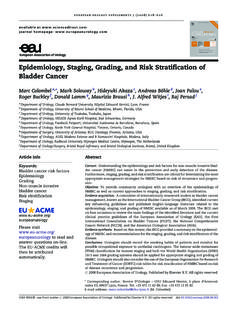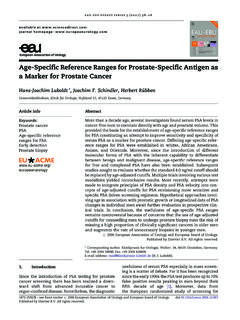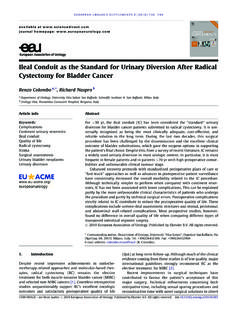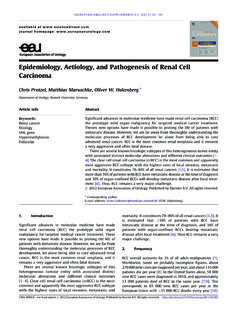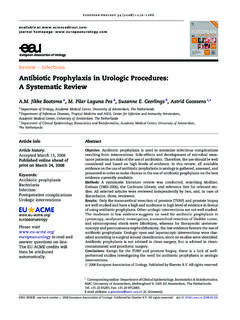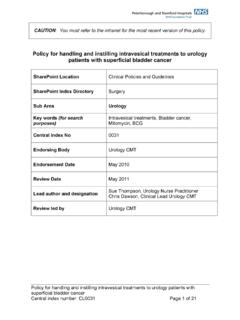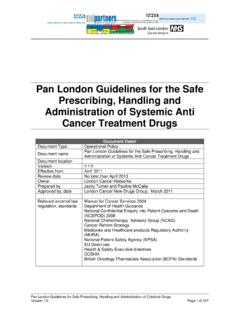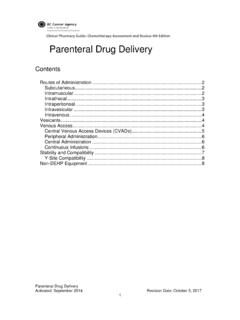Transcription of Intravesical Chemotherapy and BCG for the …
1 Intravesical Chemotherapy and BCG for the Treatment ofBladder Cancer: Evidence and OpinionGuillermo Urdanetaa, Eduardo Solsonab, Juan Paloua,*aDepartment of Urology, Fundacio Puigvert, Barcelona, SpainbDepartment of Urology, Instituto Valenciano de Oncolog a, Valencia, resection of the bladder (TURB) is wellestablished as the standard initial intervention fornon-muscle-invasive bladder cancer (bCA) and thefirst step toward a correct diagnosis and subsequentintravesical adjuvant treatment with chemotherapyor immunotherapy. The goals of Intravesical ther-apy are to (1) avoid post-TURB implantation oftumour cells, (2) eradicate residual disease, (3)prevent tumour recurrence, and (4) delay or reducetumour progression. This article considers themechanisms of action of the various agents usedpost-TURB for the Intravesical treatment of non-europeanurologysupplements7(2008)542 547available at homepage: infoKeywords:BCGC hemotherapyDisease progressionImmunotherapyIntravesical instillationNon-muscle-invasivebladder cancerRecurrencePlease read andanswer questions EU-ACME credits willthen be :Review the chemotherapeutic and immunotherapeuticoptions for post-resection Intravesical treatment of low-risk, intermedi-ate-risk, and high-risk non-muscle-invasive bladder cancer (bCA).
2 Design, Setting, and Participants:The authors conducted a review of theliterature on Chemotherapy and immunotherapy regimens used toreduce the risk of cancer recurrence and progression after transurethralresection of the bladder (TURB).Results and Limitations:The choice of post-TURB regimen for intravesicaltreatment of non-muscle-invasive bCA depends on the risk category ofthe tumour: Chemotherapy is the treatment of choice for low-risk super-ficial bladder carcinoma; intermediate-risk disease can be treated witheither Chemotherapy or immunotherapy with bacillus Calmette-Gue rin(BCG); and BCG is now the treatment of choice for high-risk tumours. Inall cases, the overall aim of treatment is to prevent recurrence and delaydisease progression. There is debate over the optimal treatment regi-mens, and the options may include sequential treatment with che-motherapy and : Intravesical Chemotherapy and BCG are both effective post-TURB treatments for non-muscle-invasive bCA, and the choice of regi-men depends on the risk category of the tumour.
3 There may also be a rolefor sequential instillations of Chemotherapy and BCG.#2008 European Association of Urology. Published by Elsevier All rights reserved.* Corresponding author. Department of Urology, Fundacio Puigvert, Cartagena No. 340 350,08025 Barcelona, Spain. Tel. +34 93 416 97 00; Fax: +34 93 416 97 Palou).1569-9056/$ see front matter#2008 European Association of Urology. Published by Elsevier All rights reserved. bCA and the evidence for theefficacy and safety of these treatments accordingto the three main risk groups (Table 1)[1]. Bacillus Calmette-Gue rinBacillus Calmette-Gue rin (BCG) acts by means of animmunological reaction strongly associated with cell apop-tosis. Furthermore, the findings of several studies suggestthat the immune response cascade in local areas of thebladder is involved in the anti-tumour mechanism of , the detailed mechanism remains to be clarified[2,3].According to de Boer and colleagues, there is a correlationbetween the level of interleukin 8 (IL-8) produced at the initialBCG instillation and the patient s immune responsiveness[4].
4 Shintani et al also report that the clinical efficacy of BCG can bepredicted from the IL-8 level within 6 h of Intravesical BCGinstillation[5]. They measured urinary cytokine levels 4 h afterthe sixth instillation of Intravesical BCG therapy and foundinfiltration of granulocytes into the bladder wall and dom-inancy of CD4+ ChemotherapyThe effect of early Chemotherapy instillations may beexplained by their destruction of circulating tumour cellsthat could otherwise implant themselves at the site of theresection or by their ability to eradicate any small tumour thatremains following incomplete resection. To obtain the bestresults from early instillation, Chemotherapy must be admi-nistered soon after TURB[6,7]. The duration of the effect (ie,time to first recurrence) varies in different studies. Solsonaet al suggest that a single, early instillation of chemotherapyremains effective for 2 yr post-TURB[8].The main anti-tumour mechanism of mitomycin C (MMC),an alkylating agent isolated fromStreptomyces caespitosus,isnot known, but its union with DNA is believed to inhibit DNAsynthesis and cause double string rupture.
5 Another theory isthat use of MMC leads to production of superoxide freeradicals that affect the integrity of DNA and cause cell necrosis[9].Alkalinisation of urine and low patient water intake mayimprove the results of MMC treatment[10]. The clinicalefficacy of multiple Intravesical instillations of MMC is difficultto determine from the literature, because the reported seriesvaries in patient populations, doses, instillation volumes, andindwelling , an anthracycline antibiotic, has limitedefficacy in bCA treatment[11]. Epirubicin, a derivative ofdoxorubicin, can be effective in patients at intermediate risk[12]. Thiotepa acts as an alkylating agent. Its efficacy fortumour prophylaxis has been demonstrated in several trials,but it has haematological side effects resulting from systemicabsorption[13]. Gemcitabine, a deoxycytidine analogue usedin Chemotherapy against several tumours, including systemictherapy for advanced bCA, inhibits growth activity, mediatesapoptosis, and has been shown to be effective and welltolerated.
6 It appears to be one of the most active systemictherapies against transitional cell carcinoma (TCC), withsignificantly better activity than Intravesical thiotepa, doxor-ubicin, epirubicin, or MMC, but further studies are neededto establish its usefulness as an Intravesical treatment[14,15]. Treatment optionsTURB followed by early Intravesical Chemotherapy instillation(for example, with MMC) is the treatment of choice for low-risksuperficial bladder carcinoma (Table 2). This strategy has beenshown to reduce the risk of recurrence and possibly preventthe implantation process[6].The treatment of choice for intermediate-risk non-muscle-invasive bCA is either Chemotherapy or immunotherapy,according to the 2006 guidelines from the European Associa-tion of Urology (EAU)[1]. A meta-analysis of 11 randomisedcontrolled trials comparing various Intravesical chemothera-pies with TURB alone has shown that Intravesical chemother-apy is associated with a 44% reduction in tumour recurrence at1 yr, with an odds ratio of (95% CI, ;p< )[16].
7 The analysis also showed that short-term, 1-yr and 2-yrschedules of Intravesical therapy are associated with respectively a 32%, 31%, and 73% reduction in tumourrecurrence compared with TURB alone. This suggests thatlonger schedules may be more beneficial than shorterschedules. In two meta-analyses focusing on the intermedi-ate-risk group, there seemed to be no difference in recurrencebetween Intravesical Chemotherapy and immunotherapy[17,18].For high-risk tumours, post-TURB treatment with BCG hasbecome one of the most successful and low-cost immu-notherapies available. It is highly effective for the preventionTable 1 Classification of risk groups according to the2006 European guidelines [1]Low riskIntermediateriskHighriskG1 2 TaMultifocal G2Ta,G1T1, solitary G2T1 Multifocal G2T1,G3Ta T1, CIST able 2 Treatment options by risk groupRisk groupTreatmentLow riskEarly chemotherapyIntermediate riskEarly chemotherapyChemotherapyImmunotherapyHig h riskImmunotherapyChemotherapy + immunotherapyChemotherapy + hyperthermiaChemotherapy + EMDAC ystectomyEMDA, electromotive drug (2008)542 547543of recurrence and progression of Ta and T1 bladder tumoursand carcinoma in situ (CIS) compared with TURB alone[1].
8 Unfortunately, all of the above adjuvant treatments havelimitations in terms of disease recurrence or progression andmorbidity. There is increasing interest in alternative first-linedrugs (eg, gemcitabine and apaziquone [EO9])[19,20], althoughthe results are not yet mature, and in second-line therapies(eg, Intravesical microwave hyperthermia in combinationwith Intravesical Chemotherapy or electromotive drug admin-istration [EMDA;21,22]). The combination of intravesicalmitomycin and the application of hyperthermia (428, deliveredusing a microwave applicator) has been shown to reducerecurrence[21]. Furthermore, there is evidence of a decrease indisease recurrence and even in disease progression with thesequential combination of BCG and electromotive mitomycin,which increases the penetration of the drug into the bladderwall[23]. meta-analysis of the results of randomised clinicaltrials comparing TURB alone with TURB plus oneimmediate instillation of Chemotherapy (epirubicin,MMC, thiotepa, or pirarubicin) has shown that asingle, immediate Chemotherapy instillation signif-icantly decreases the risk of bCA recurrence inpatients with stage-Ta/T1 single and multiplebladder tumours, and the authors recommend thisstrategy as the treatment of choice for patients withone low-risk papillary tumour[6].
9 Further intrave-sical treatment is needed for patients with inter-mediate-risk and high-risk tumours, althoughpatients who have received an early post-TURB instillation do not seem to require long-termmaintenance 6 mo of Intravesical chemotherapyproduces good results[24].In a Cochrane meta-analysis, Shelley et al con-clude that post-TURB instillation of BCG providessignificantly better prophylaxis of tumour recur-rence in Ta and T1 urothelial bCA compared withTURB alone[25]. Two meta-analyses have alsodemonstrated delayed disease progression inpatients treated with BCG[26,27]. BCG versus chemotherapyVarious studies have shown that Intravesical BCGproduces better results than Chemotherapy [28 31].For example, in one multicentre study of patientswith Ta and T1 tumours and without CIS, theestimated probability of being disease free at 5 yrwas 17% after doxorubicin, compared with 37% afterBCG immunotherapy (p= )[11].However, there have also been several studiesshowing few differences between chemotherapyand immunotherapy in intermediate-risk bCA, soboth types of treatment are accepted as standard inthis patient group[1].
10 One randomised, multicentrephase 4 clinical trial of short-term and long-termMMC versus short-term BCG after TURB for non-muscle-invasive bCA suggests that patients with Ta/G1 tumours are significantly less likely to experiencerecurrence after long-term MMC (3 yr) than aftershort-term BCG (6 wk) or short-term MMC (6 wk),and without enhanced toxicity[31]. Patients treatedwith short-term BCG instillations had a rate at 1 yr, compared with inthe short-term MMC group and in thosereceiving long-term MMC. Recurrence-free rates inthe second and third year were, respectively, for short-term MMC, and forshort-term BCG, and and for long-termMMC. Sekine et al have compared the efficacy ofintravesical therapy with MMC plus doxorubicinversus BCG in 42 patients with CIS and conclude thatboth strategies are equally effective as initialtherapy and that a combination of both would bethe most efficient treatment for CIS[32]. In 2007, theGreek Bladder Cancer Study Group presented theresults of a prospective, randomised, comparativestudy of high-dose (80 mg) Intravesical epirubicinand BCG as prophylaxis for cancer recurrence in234 patients with intermediate-risk superficial TCC[33].

